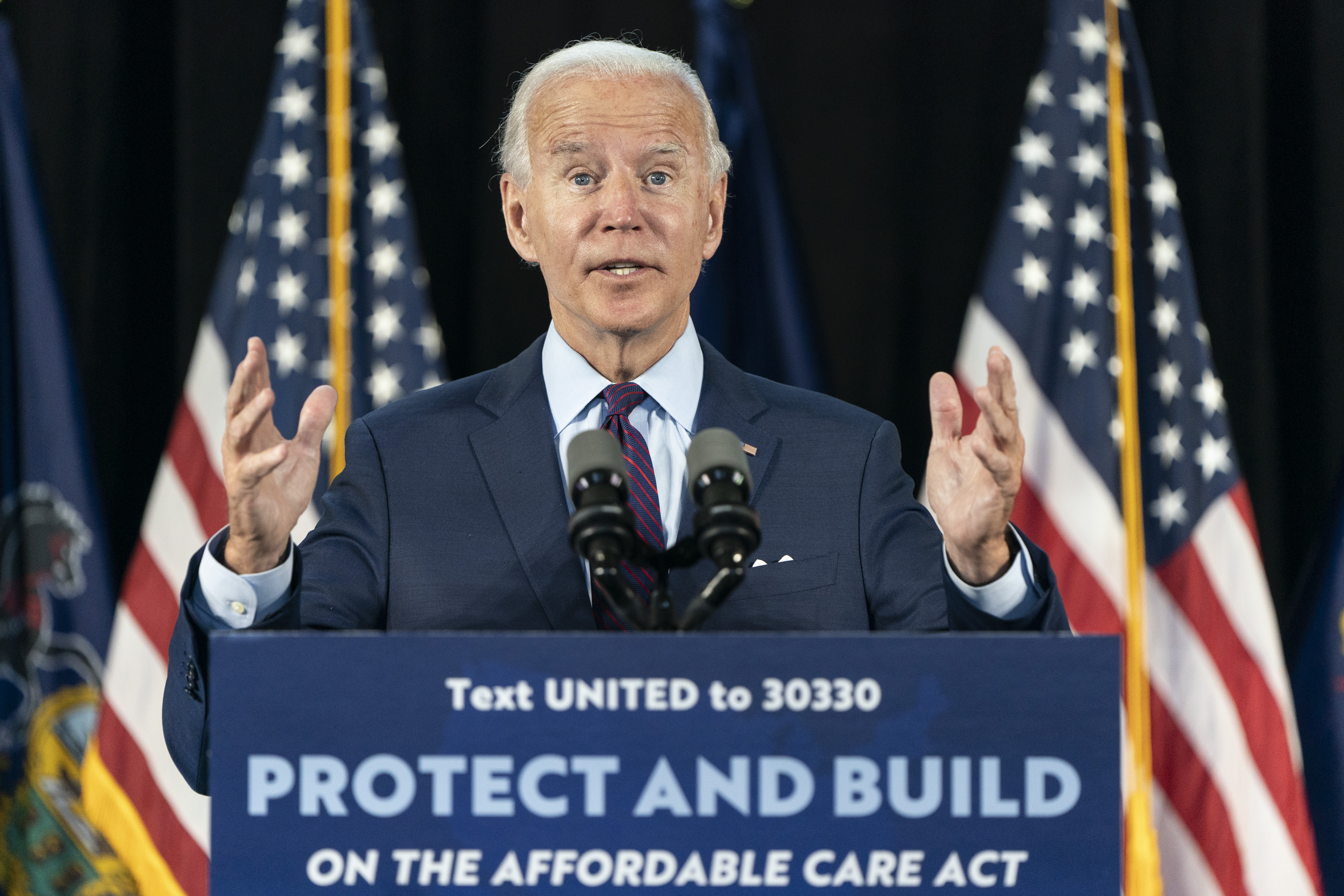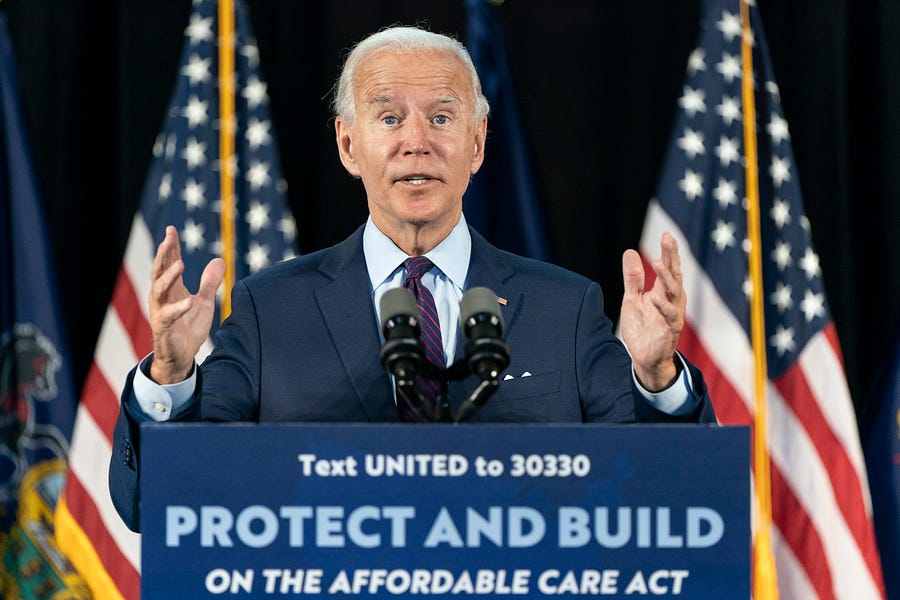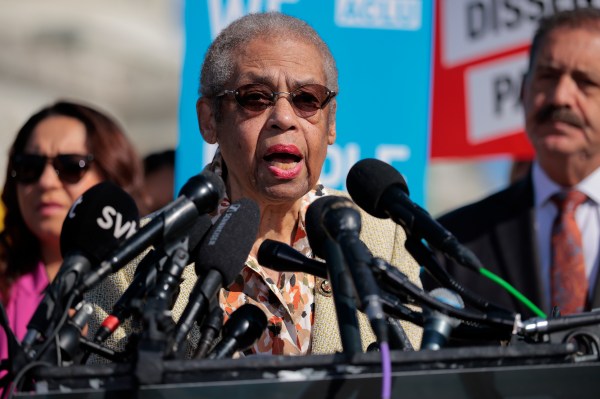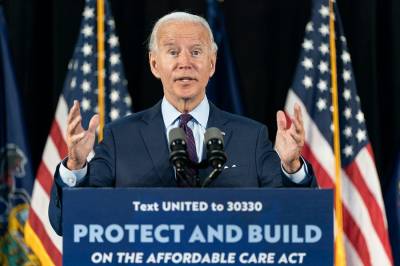Good morning and welcome to “The Biden Agenda.” For the past several weeks, we've invited some of the smartest thinkers and subject-matter experts we know to contribute to what will become an occasional series on what a Biden presidency might look like.
The idea is simple: Based on Biden's long career, the views he's articulated in his low-key campaign for president, the people he's likely to rely on for advice, and the current political moment, what should we expect from a prospective Biden presidency on the most pressing issues of our time? We've asked contributors to assume a Biden presidency and provide for readers an idea of what to expect.
While polling today points to a Biden presidency as likely—the forecast from modeling created by The Economist puts the odds at roughly 9 in 10—such polling is necessarily a just snapshot. There are reasons to believe the polls will tighten over the final three months of the presidential contest and externalities can produce rapid and significant change to current trends. We will continue our in-depth reporting and analysis of the Trump presidency and a prospective second term as part of our ongoing coverage.
The first piece comes from Jim Capretta, one of the country's leading experts on health care, entitlements, budgets and fiscal policy. Capretta holds the Milton Friedman chair at the American Enterprise Institute and serves as an adviser to the Bipartisan Policy Center.

Joe Biden—slayer of Medicare for All—saved Democrats from a painful, self-inflicted wound. If a candidate supporting single-payer had won the nomination, the party would be pulling out all of the stops to get it enacted in 2021, and almost certainly would fail even if the candidate won the presidency in November. As things stand, Biden’s nomination allows Democrats to champion more realistic and politically palatable changes that move in the same direction. The COVID-19 pandemic is providing new momentum for such an agenda.
Throughout the Democratic debates of 2019 and early 2020, Biden set himself apart from Sens. Bernie Sanders and Elizabeth Warren by aggressively criticizing Medicare for All. He repeatedly noted its high cost—in excess of $30 trillion over 10 years—and its elimination of private insurance, including for the 160 million Americans under age 65 enrolled in job-based coverage. When presented with these facts, many of the party’s rank and file recoiled, all but ensuring that Biden would secure the nomination.
If Biden were to win the presidency in November, he and his aides would translate his campaign positions into a legislative and regulatory plan that would be a logical extension of the party’s efforts over the past half-century. The overall theme has been, and will be, steady movement toward a system of full federal control but with policies that voters with private coverage do not find alarming.
The COVID-19 pandemic, and the severe economic upheaval it has precipitated, are leading some party activists to call on Biden to become more aggressive, saying that the current circumstances are laying bare the deficiencies of American health care, and thus set the stage for an embrace of Medicare for All.
It’s a dubious claim. The pandemic has certainly exposed gaps in the nation’s readiness for a public health emergency, but that does not translate into added support for government-run health insurance. Indeed, the case can be made that the pandemic has exposed the problems that occur when hospitals and physician practices are paid too little by government-administered insurance plans.
Biden has responded to the changed environment by taking steps toward the Sanders-Warren wing without abandoning what won him the nomination. Over the summer, in the name of party unity, a team of Biden supporters negotiated a revised policy platform with the vanquished remains of the Sanders campaign. Biden still opposes Medicare for All, but he has embraced an even more active federal role in governing the system.
The campaign’s revised policy platform, along with prominent bills that have already been supported by congressional Democrats, point toward the likely components of a Biden administration health policy agenda.
Reversal of the Trump Agenda
Save for repeal of the ACA’s individual mandate, the Trump administration has had no success passing legislative reforms in health care, as demonstrated most spectacularly by the collapse of its ACA repeal-and-replace scheme in 2017. It has had more success implementing regulatory and other administrative changes, with the most consequential involving relaxation of rules governing the individual insurance market. The administration has freed insurers to sell short-term plans that do not conform to the ACA’s required benefits or underwriting ban. Consumers in good health can now buy these products at discounted rates for up to three years. A Biden administration is sure to kill this modification to the ACA, and to reverse several other decisions aimed at allowing younger and healthier consumers to escape the strictures of community-rated premiums. It will also pour more funds into promoting ACA enrollment during the fall open season.
Some Trump initiatives may survive the transition, however. For instance, the administration’s policy allowing workers to use Health Reimbursement Arrangements (HRAs) to pay for individual coverage in the ACA-regulated market furthers the GOP goal of empowering consumer choice, but does so by increasing reliance on the ACA. A Biden administration is likely to monitor this policy, and possibly erect new conditions, rather than kill it altogether.
Expansion of the Affordable Care Act
In June, House Democrats passed the Patient Protection and Affordable Care Enhancement Act. It would increase the subsidies for health insurance enrollment provided in the ACA for all income levels, and provide a cap on premium costs for families over 400 percent of the poverty line at 8.5 percent of their incomes, provided that they are buying insurance through the ACA’s exchanges. This added spending, along with further incentives for the states to accept the ACA’s Medicaid expansion, would cost about $600 billion over 10 years.
Drug Pricing
The Democrats have suggested paying for the expensive provisions in the ACA expansion bill by imposing tighter federal controls on the pricing of prescription drugs (that the party had previously promised to devote the expected savings to adding vision and dental coverage to Medicare was of no consequence). The prescription drug changes were negotiated over the course of 2019 by House Speaker Nancy Pelosi and passed in H.R. 3 in December. Its key provision would limit what Medicare pays for drugs to the lesser of a rate negotiated by the secretary of health and human services (HHS) with manufacturers or a rate derived from an index of pricing found in other advanced economies. The Congressional Budget Office (CBO) estimates H.R. 3 would cut federal spending by nearly $500 billion over 10 years. A more aggressive version could push the total to $600 billion or higher.
The House-passed bill represents what President Trump probably had in mind when he campaigned on drug price controls in 2016. Once in office, he found out that most Republicans were unwilling to follow his lead and tie prices paid in the U.S. to the regulated rates of Europe and elsewhere. A Biden administration would face no such resistance among its allies, and so would have a much better chance of passing a consequential bill through Congress.
Public Health and Pandemic Preparedness
The coronavirus pandemic, and the U.S.’s abysmal response, is compelling both parties to look at emergency preparedness measures as well as broader public health funding. A Biden administration is sure to use widespread dissatisfaction with the country’s state of readiness to push for a permanent funding source to support vastly expanded stockpiling of essential supplies, surge capacity support for hospitals and labs, and incentives for ongoing development of vaccines and therapeutics. Further, there will be a concerted effort to tie public health funding to a broader agenda of reducing disparities in access to services for minorities and lower-income households. This agenda will be expensive—tens of billions of dollars—but far less costly than expansion of the ACA’s subsidy structure and Medicaid.
The GOP may try to resist this effort because of its cost, but it is likely to have bipartisan appeal with voters who want an assurance that the country will never again repeat what transpired in 2020.
A New Public Option and an Expansion of Medicare
The most consequential, and also controversial, items on Biden’s list are the public option and an expansion of Medicare to those age 60 to 64. Neither of these ideas would be easy to get through Congress, even with Democrats in charge of both chambers, but a public option would have slightly better odds.
During the ACA debate in 2009 and 2010, many Democrats supported creation of a federally-run insurance plan that would be offered to consumers alongside private coverage. The idea was dropped because of opposition from a handful of Senate Democrats. In 2021, there would be less resistance to the concept inside the party.
The public option is sold as a Medicare-like insurance plan for working-age Americans. The federal government would collect premiums from enrollees, and pay hospitals and physicians directly for the services they provide. The Biden campaign says provider payments would be negotiated, which it claims is the practice in Medicare. But Medicare doesn’t negotiate rates; it imposes them by regulation on a take-it-or-leave it basis. Medicare pays about half of average commercial rates for hospital care, and 70 percent for physician services.
Use of Medicare’s regulated payments would allow a public option to charge premiums far below those of competing private plans. The Biden campaign envisions making the new option available to all non-Medicare consumers, including workers who are offered job-based coverage. If the premium savings is large enough, a public option could have tens of millions of customers within a few years.
What is not known now, and won’t be until a bill is actively considered in Congress, is whether Democrats will give a public option what it needs to become dominant, which is the ability to force all doctors and hospitals to participate in its network. A bill in Congress—dubbed Medicare X – would require any hospital or doctor participating in Medicare to also accept public option enrollees.
The medical community is well aware of the power such a provision would confer on a public option. They would have no choice but to sign up, lest they lose all of their Medicare revenue. Its heavy-handedness will make it a hard sell in Congress however, and the medical community will do all it can to prevent it from becoming law.
If provider participation is voluntary, then the public option would have two options. It could offer enrollees a narrower network of participating facilities and practitioners, or it could charge higher premiums to support more attractive payment levels. Either way, the new public plan would have less enrollment than it would with compulsory provider participation.
Biden would make the new public option the default plan for the uninsured, and he would subsidize its premiums through the structure enacted in the ACA. It is certain to draw significant enrollment even if participation remains voluntary for the providers.
A lowering of the age of eligibility for Medicare to 60 would be an even more consequential change. It would increase enrollment in the program by some 20 million people, most of whom already have insurance from other sources. Thus, the policy would mainly substitute public spending—perhaps as much as $40-$100 billion annually—for private expenditures. Further, Medicare’s finances are already strained; even before factoring in the pandemic, projections show the Hospital Insurance (HI) trust fund will deplete its reserves in 2026. Rising unemployment could move the date up to 2023. Congress may find it difficult to add so many new enrollees to Medicare before providing assurances to existing beneficiaries that the program can fully cover promised benefits.
The degree of Democratic ambition in 2021 will depend heavily on what transpires in November. If a Biden victory brings with it a working majority in the Senate, then the possibilities expand. They will grow further if the majority is such that the party feels emboldened to jettison the Senate’s legislative filibuster.
Although such a convincing Democratic victory is possible, it is far from certain. President Trump could still win re-election, at which point all of this speculation would be moot. And even if he loses, Republicans may hold onto the Senate, which would force a scaling back of the Biden agenda. First to go would be the Medicare expansion, but the public option would be in peril, too. The rest of the agenda might move forward in a modified form; renewed support for the ACA and expanded public health and preparedness funding have the potential for some bipartisan support.
Further, even if the GOP does lose the Senate, moderate Democrats may still stand in the way of abandoning the filibuster. If the filibuster stays, it is likely that a Biden administration would work with House and Senate leaders to move as much of its agenda as possible through the budget reconciliation process, which allows bills to pass in the Senate with simple majorities. That process is cumbersome, and precludes authorization changes that have no effects on the budget, but it would allow Democrats to bypass Republicans to enact many significant changes that increase federal spending and raise taxes.
President Trump is running for re-election in an environment that strongly favors a challenger. The world is engulfed in a pandemic. The economy has fallen into a deep recession. Millions of Americans have lost their jobs, which means many of them are also losing their health insurance. The possibility of contracting the SARS-CoV-2 virus is driving home the point that none of us are invulnerable. The conditions are ripe for a change in direction, and possibly for a period of renewed governmental activism.
Enter Joe Biden. He won the Democratic nomination by highlighting the drawbacks of single-payer health care. By so doing, he may have put himself in the position of presiding over the most consequential changes in health care since the 1960s. A different nominee might be pushing for goals that seem more ambitious but are far less attainable. Biden’s relative moderation may have set the party up for achieving far more.






Please note that we at The Dispatch hold ourselves, our work, and our commenters to a higher standard than other places on the internet. We welcome comments that foster genuine debate or discussion—including comments critical of us or our work—but responses that include ad hominem attacks on fellow Dispatch members or are intended to stoke fear and anger may be moderated.
With your membership, you only have the ability to comment on The Morning Dispatch articles. Consider upgrading to join the conversation everywhere.